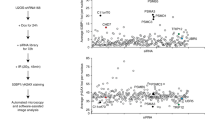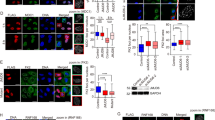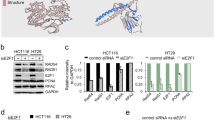Abstract
The chromodomain helicase DNA-binding proteins (CHDs) are known to affect transcription through their ability to remodel chromatin and modulate histone deacetylation. In an effort to understand the functional role of the CHD2 in mammals, we have generated a Chd2 mutant mouse model. Remarkably, the Chd2 protein appears to play a critical role in the development, hematopoiesis and tumor suppression. The Chd2 heterozygous mutant mice exhibit increased extramedullary hematopoiesis and susceptibility to lymphomas. At the cellular level, Chd2 mutants are defective in hematopoietic stem cell differentiation, accumulate higher levels of the chromatin-associated DNA damage response mediator, γH2AX, and exhibit an aberrant DNA damage response after X-ray irradiation. Our data suggest a direct role for the chromatin remodeling protein in DNA damage signaling and genome stability maintenance.
This is a preview of subscription content, access via your institution
Access options
Subscribe to this journal
Receive 50 print issues and online access
$259.00 per year
only $5.18 per issue
Buy this article
- Purchase on Springer Link
- Instant access to full article PDF
Prices may be subject to local taxes which are calculated during checkout




Similar content being viewed by others
References
Bagchi A, Papazoglu C, Wu Y, Capurso D, Brodt M, Francis D et al. (2007). Chd5 is a tumor suppressor at human 1p36. Cell 128: 459–475.
Banath JP, Olive PL . (2003). Expression of phosphorylated histone h2ax as a surrogate of cell killing by drugs that create DNA double-strand breaks. Cancer Res 63: 4347–4350.
Bernstein BE, Humphrey EL, Erlich RL, Schneider R, Bouman P, Liu JS et al. (2002). Methylation of histone h3 lys 4 in coding regions of active genes. Proc Natl Acad Sci USA 99: 8695–8700.
Brehm A, Langst G, Kehle J, Clapier CR, Imhof A, Eberharter A et al. (2000). Dmi-2 and iswi chromatin remodelling factors have distinct nucleosome binding and mobilization properties. EMBO J 19: 4332–4341.
Bronson RT, Lipman RD . (1991). Reduction in rate of occurrence of age related lesions in dietary restricted laboratory mice. Growth Dev Aging 55: 169–184.
Cowell IG, Austin CA . (1997). Self-association of chromo domain peptides. Biochim Biophys Acta 1337: 198–206.
Delmas V, Stokes DG, Perry RP . (1993). A mammalian DNA-binding protein that contains a chromodomain and an snf2/swi2-like helicase domain. Proc Natl Acad Sci USA 90: 2414–2418.
Downs JA, Lowndes NF, Jackson SP . (2000). A role for saccharomyces cerevisiae histone h2a in DNA repair. Nature 408: 1001–1004.
Feys T, Poppe B, De Preter K, Van Roy N, Verhasselt B, De Paepe P et al. (2007). A detailed inventory of DNA copy number alterations in four commonly used Hodgkin's lymphoma cell lines. Haematologica 92: 913–920.
Flanagan JF, Mi LZ, Chruszcz M, Cymborowski M, Clines KL, Kim Y et al. (2005). Double chromodomains cooperate to recognize the methylated histone h3 tail. Nature 438: 1181–1185.
Fukasawa M, Morita S, Kimura M, Horii T, Ochiya T, Hatada I . (2006). Genomic imprinting in dicer1-hypomorphic mice. Cytogenet Genome Res 113: 138–143.
Gao X, Gordon D, Zhang D, Browne R, Helms C, Gillum J et al. (2007). Chd7 gene polymorphisms are associated with susceptibility to idiopathic scoliosis. Am J Hum Genet 80: 957–965.
Gonzalez-Billault C, Demandt E, Wandosell F, Torres M, Bonaldo P, Stoykova A et al. (2000). Perinatal lethality of microtubule-associated protein 1b-deficient mice expressing alternative isoforms of the protein at low levels. Mol Cell Neurosci 16: 408–421.
Hasan S, Hottiger MO . (2002). Histone acetyl transferases: a role in DNA repair and DNA replication. J Mol Med 80: 463–474.
Heyworth C, Pearson S, May G, Enver T . (2002). Transcription factor-mediated lineage switching reveals plasticity in primary committed progenitor cells. EMBO J 21: 3770–3781.
Iwasaki H, Mizuno S, Wells RA, Cantor AB, Watanabe S, Akashi K . (2003). Gata-1 converts lymphoid and myelomonocytic progenitors into the megakaryocyte/erythrocyte lineages. Immunity 19: 451–462.
Jeganathan K, Malureanu L, Baker DJ, Abraham SC, van Deursen JM . (2007). Bub1 mediates cell death in response to chromosome missegregation and acts to suppress spontaneous tumorigenesis. J Cell Biol 179: 255–267.
Jin J, Cai Y, Li B, Conaway RC, Workman JL, Conaway JW et al. (2005). In and out: histone variant exchange in chromatin. Trends Biochem Sci 30: 680–687.
Jones DO, Cowell IG, Singh PB . (2000). Mammalian chromodomain proteins: their role in genome organisation and expression. Bioessays 22: 124–137.
Kang J, Ferguson D, Song H, Bassing C, Eckersdorff M, Alt FW et al. (2005). Functional interaction of h2ax, nbs1, and p53 in atm-dependent DNA damage responses and tumor suppression. Mol Cell Biol 25: 661–670.
Kina T, Ikuta K, Takayama E, Wada K, Majumdar AS, Weissman IL et al. (2000). The monoclonal antibody ter-119 recognizes a molecule associated with glycophorin a and specifically marks the late stages of murine erythroid lineage. Br J Haematol 109: 280–287.
Kulkarni S, Nagarajan P, Wall J, Donovan DJ, Donell RL, Ligon AH et al. (2008). Disruption of chromodomain helicase DNA binding protein 2 (CHD2) causes scoliosis. Am J Med Genet A 146A: 1117–1127.
Kusch T, Florens L, Macdonald WH, Swanson SK, Glaser RL, Yates III JR et al. (2004). Acetylation by tip60 is required for selective histone variant exchange at DNA lesions. Science 306: 2084–2087.
Lalani SR, Safiullah AM, Fernbach SD, Harutyunyan KG, Thaller C, Peterson LE et al. (2006). Spectrum of chd7 mutations in 110 individuals with charge syndrome and genotype-phenotype correlation. Am J Hum Genet 78: 303–314.
Lukas C, Melander F, Stucki M, Falck J, Bekker-Jensen S, Goldberg M et al. (2004). Mdc1 couples DNA double-strand break recognition by nbs1 with its h2ax-dependent chromatin retention. EMBO J 23: 2674–2683.
Lusser A, Urwin DL, Kadonaga JT . (2005). Distinct activities of chd1 and acf in atp-dependent chromatin assembly. Nat Struct Mol Biol 12: 160–166.
Marfella CG, Ohkawa Y, Coles AH, Garlick DS, Jones SN, Imbalzano AN . (2006). Mutation of the snf2 family member chd2 affects mouse development and survival. J Cell Physiol 209: 162–171.
Morrison AJ, Highland J, Krogan NJ, Arbel-Eden A, Greenblatt JF, Haber JE et al. (2004). Ino80 and gamma-h2ax interaction links atp-dependent chromatin remodeling to DNA damage repair. Cell 119: 767–775.
Muller C, Leutz A . (2001). Chromatin remodeling in development and differentiation. Curr Opin Genet Dev 11: 167–174.
Ney PA . (2006). Gene expression during terminal erythroid differentiation. Curr Opin Hematol 13: 203–208.
Osley MA, Tsukuda T, Nickoloff JA . (2007). Atp-dependent chromatin remodeling factors and DNA damage repair. Mutat Res 618: 65–80.
Paro R, Hogness DS . (1991). The polycomb protein shares a homologous domain with a heterochromatin-associated protein of drosophila. Proc Natl Acad Sci USA 88: 263–267.
Paull TT, Rogakou EP, Yamazaki V, Kirchgessner CU, Gellert M, Bonner WM . (2000). A critical role for histone h2ax in recruitment of repair factors to nuclear foci after DNA damage. Curr Biol 10: 886–895.
Pray-Grant MG, Daniel JA, Schieltz D, Yates III JR, Grant PA . (2005). Chd1 chromodomain links histone h3 methylation with saga- and slik-dependent acetylation. Nature 433: 434–438.
Qin S, Parthun MR . (2002). Histone h3 and the histone acetyltransferase hat1p contribute to DNA double-strand break repair. Mol Cell Biol 22: 8353–8365.
Rogakou EP, Pilch DR, Orr AH, Ivanova VS, Bonner WM . (1998). DNA double-stranded breaks induce histone h2ax phosphorylation on serine 139. J Biol Chem 273: 5858–5868.
Rothkamm K, Kruger I, Thompson LH, Lobrich M . (2003). Pathways of DNA double-strand break repair during the mammalian cell cycle. Mol Cell Biol 23: 5706–5715.
Schuster E . (2002). Chd5 defines a new subfamily of chromodomain-swi2/snf2-like helicases. Mamm Genome 13: 117–119.
Simic R, Lindstrom DL, Tran HG, Roinick KL, Costa PJ, Johnson AD et al. (2003). Chromatin remodeling protein chd1 interacts with transcription elongation factors and localizes to transcribed genes. EMBO J 22: 1846–1856.
Sims III RJ, Chen CF, Santos-Rosa H, Kouzarides T, Patel SS, Reinberg D . (2005). Human but not yeast chd1 binds directly and selectively to histone h3 methylated at lysine 4 via its tandem chromodomains. J Biol Chem 280: 41789–41792.
Singh PB, Miller JR, Pearce J, Kothary R, Burton RD, Paro R et al. (1991). A sequence motif found in a Drosophila heterochromatin protein is conserved in animals and plants. Nucleic Acids Res 19: 789–794.
Socolovsky M, Nam H, Fleming MD, Haase VH, Brugnara C, Lodish HF . (2001). Ineffective erythropoiesis in stat5a(−/−)5b(−/−) mice due to decreased survival of early erythroblasts. Blood 98: 3261–3273.
Spike BT, Dirlam A, Dibling BC, Marvin J, Williams BO, Jacks T et al. (2004). The rb tumor suppressor is required for stress erythropoiesis. EMBO J 23: 4319–4329.
Stokes DG, Perry RP . (1995). DNA-binding and chromatin localization properties of chd1. Mol Cell Biol 15: 2745–2753.
Stryke D, Kawamoto M, Huang CC, Johns SJ, King LA, Harper CA et al. (2003). Baygenomics: a resource of insertional mutations in mouse embryonic stem cells. Nucleic Acids Res 31: 278–281.
Takeda Y, Dynan WS . (2001). Autoantibodies against DNA double-strand break repair proteins. Front Biosci 6: D1412–D1422.
Targoff IN, Reichlin M . (1985). The association between mi-2 antibodies and dermatomyositis. Arthritis Rheum 28: 796–803.
Thomas JO . (2001). Hmg1 and 2: architectural DNA-binding proteins. Biochem Soc Trans 29: 395–401.
Tong JK, Hassig CA, Schnitzler GR, Kingston RE, Schreiber SL . (1998). Chromatin deacetylation by an atp-dependent nucleosome remodelling complex. Nature 395: 917–921.
Tran H . (2000). The chromo domain protein chd1p from budding yeast is an atp-dependent chromatin-modifying factor. EMBO J 10: 2323–2331.
Tsukuda T, Fleming AB, Nickoloff JA, Osley MA . (2005). Chromatin remodelling at a DNA double-strand break site in saccharomyces cerevisiae. Nature 438: 379–383.
van Attikum H, Fritsch O, Hohn B, Gasser SM . (2004). Recruitment of the ino80 complex by h2a phosphorylation links atp-dependent chromatin remodeling with DNA double-strand break repair. Cell 119: 777–788.
Venkatachalam S, Shi YP, Jones SN, Vogel H, Bradley A, Pinkel D et al. (1998). Retention of wild-type p53 in tumors from p53 heterozygous mice: Reduction of p53 dosage can promote cancer formation. EMBO J 17: 4657–4667.
Vissers LE, van Ravenswaaij CM, Admiraal R, Hurst JA, de Vries BB, Janssen IM et al. (2004). Mutations in a new member of the chromodomain gene family cause charge syndrome. Nat Genet 36: 955–957.
Voss AK, Thomas T, Gruss P . (1998). Compensation for a gene trap mutation in the murine microtubule-associated protein 4 locus by alternative polyadenylation and alternative splicing. Dev Dyn 212: 258–266.
Wang GG, Allis CD, Chi P . (2007a). Chromatin remodeling and cancer, part i: covalent histone modifications. Trends Mol Med 13: 363–372.
Wang GG, Allis CD, Chi P . (2007b). Chromatin remodeling and cancer, part ii: Atp-dependent chromatin remodeling. Trends Mol Med 13: 373–380.
Whiteford ML, Baird C, Kinmond S, Donaldson B, Davidson HR . (2000). A child with bisatellited, dicentric chromosome 15 arising from a maternal paracentric inversion of chromosome 15q. J Med Genet 37: E11.
Wilson GN, Sauder SE, Bush M, Beitins IZ . (1985). Phenotypic delineation of ring chromosome 15 and russell-silver syndromes. J Med Genet 22: 233–236.
Woodage T . (1997). Chracterization of the chd family of proteins. Proc Natl Acad Sci 94: 11472–11477.
Wu C . (1997). Chromatin remodeling and the control of gene expression. J Biol Chem 272: 28171–28174.
Xue Y, Wong J, Moreno GT, Young MK, Cote J, Wang W . (1998). Nurd, a novel complex with both atp-dependent chromatin-remodeling and histone deacetylase activities. Mol Cell 2: 851–861.
Zhang J, Socolovsky M, Gross AW, Lodish HF . (2003). Role of ras signaling in erythroid differentiation of mouse fetal liver cells: functional analysis by a flow cytometry-based novel culture system. Blood 102: 3938–3946.
Zhang Y, Leroy G, Seelig H, Lane W, Reinberg D . (1998). The dermatomysitis-specific autoantigen mi2 is a component of a complex containing histone deacetylase and nucleosome remodeling activites. Cell 95: 279–289.
Acknowledgements
We are thankful to Dr Bruce McKee for critically reading the manuscript. This work was supported by the University of Tennessee startup funds, PMERF seed funds, and NIH funds (00293621) to SV and funding from NIH (AI05771901) to TMO.
Author information
Authors and Affiliations
Corresponding author
Additional information
Supplementary Information accompanies the paper on the Oncogene website (http://www.nature.com/onc)
Rights and permissions
About this article
Cite this article
Nagarajan, P., Onami, T., Rajagopalan, S. et al. Role of chromodomain helicase DNA-binding protein 2 in DNA damage response signaling and tumorigenesis. Oncogene 28, 1053–1062 (2009). https://doi.org/10.1038/onc.2008.440
Received:
Revised:
Accepted:
Published:
Issue Date:
DOI: https://doi.org/10.1038/onc.2008.440
Keywords
This article is cited by
-
Regulation of human cortical interneuron development by the chromatin remodeling protein CHD2
Scientific Reports (2022)
-
CHD3/4/5/6/8 serve as potential prognostic predictors in human gastric cancer
Network Modeling Analysis in Health Informatics and Bioinformatics (2021)
-
Regulation of CHD2 expression by the Chaserr long noncoding RNA gene is essential for viability
Nature Communications (2019)
-
Epigenetic Mistakes in Neurodevelopmental Disorders
Journal of Molecular Neuroscience (2017)
-
Detection of Potential Metastatic Prostate Cancer Circulating Biomarkers by Comparison of miRNA Profiles in DU145 Cells and Culture Medium
Bulletin of Experimental Biology and Medicine (2017)



